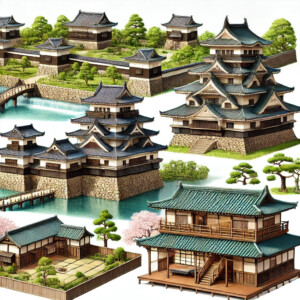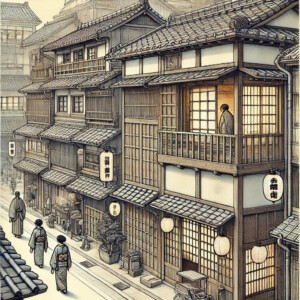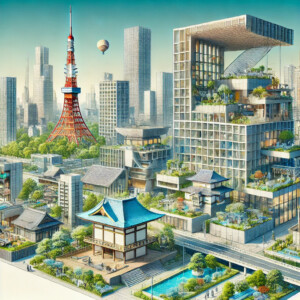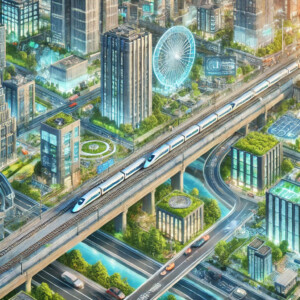1. Introduction
Japanese architecture is a reflection of the country’s rich cultural history, evolving through various periods and integrating traditional and modern elements. This article explores the significance of architecture in Japanese culture, tracing its evolution from ancient times to the present day.
2. Ancient Japanese Architecture

Shinto Shrines and Buddhist Temples
- Architectural Features and Religious Significance Shinto shrines and Buddhist temples are the oldest forms of Japanese architecture, dating back to the 6th century. Shinto shrines, such as the famous Ise Shrine, are characterized by their simple, natural wooden structures, thatched roofs, and lack of nails, emphasizing harmony with nature. They are built to honor kami (spirits) and are often surrounded by sacred forests.
Buddhist temples, introduced from China and Korea, brought new architectural elements, including pagodas and large, intricate wooden structures. Todai-ji in Nara, housing the Great Buddha, is an iconic example, showcasing the grandeur and sophistication of early Buddhist architecture.
Notable Examples
- Ise Shrine: Rebuilt every 20 years, this shrine embodies the Shinto belief in renewal and impermanence. Its architecture features the shinmei-zukuri style, with a raised floor and unpainted cypress wood.
- Todai-ji: Home to the world’s largest bronze statue of Buddha, this temple complex illustrates the adaptation and integration of Chinese architectural principles, with expansive halls and intricate wooden carvings.
3. Feudal Japan

Castles and Samurai Residences
- Structure and Purpose Japanese castles were both fortresses and symbols of power during the feudal period. Built primarily from wood and stone, they featured defensive elements such as moats, high walls, and watchtowers. The interiors were designed for both residential and administrative purposes, with tatami-matted rooms and sliding doors.
Samurai residences, or buke-yashiki, were fortified homes that reflected the samurai’s status. These homes often included gardens, tea houses, and guest rooms, emphasizing both practicality and aesthetic beauty.
Examples
- Himeji Castle: Known as the “White Heron Castle” for its elegant, white appearance, Himeji is a UNESCO World Heritage site. Its complex design, including multiple defensive layers and a labyrinth of pathways, exemplifies the pinnacle of Japanese castle architecture.
- Matsumoto Castle: Nicknamed “Crow Castle” for its black exterior, this castle is one of Japan’s oldest and features a unique combination of defensive structures and residential quarters, highlighting the dual purpose of these edifices.
4. Edo Period

Machiya and Merchant Houses
- Description and Function During the Edo period, urbanization led to the development of machiya, traditional wooden townhouses that served as both residences and places of business for merchants. These narrow, elongated buildings typically had a storefront facing the street, with living quarters and a garden at the back.
The interior design of machiya focused on maximizing space and light, with features like sliding doors (fusuma) and paper screens (shoji). The use of natural materials, such as wood and paper, created a harmonious and flexible living environment.
Cultural Impact Machiya played a crucial role in the social and economic life of Edo-period cities, fostering a sense of community and continuity. Their design principles, emphasizing simplicity, functionality, and a connection to nature, continue to influence modern Japanese architecture.
Examples
- Kyoto Machiya: Many of these traditional townhouses have been preserved and converted into museums, shops, and guesthouses, allowing visitors to experience the historical ambiance and architectural ingenuity of the Edo period.
- Nara Machiya: Nara’s preserved machiya offer insights into the daily lives of merchants, with carefully restored interiors that showcase traditional craftsmanship and urban living.
Conclusion of Part 1
The architectural heritage of Japan is a testament to the country’s ability to blend tradition with innovation. From the spiritual sanctuaries of Shinto shrines and Buddhist temples to the fortified grandeur of feudal castles and the urban sophistication of Edo-period machiya, each architectural style reflects a unique aspect of Japanese culture and history.
5. Modern Japanese Architecture

Western Influence and Modernization
- The Meiji Restoration The Meiji Restoration (1868) marked a significant turning point in Japanese architecture. As Japan opened up to the West, there was a rapid influx of Western architectural styles and techniques. This period saw the construction of Western-style government buildings, schools, and other public structures.
Architects like Josiah Conder, a British architect, played a pivotal role in training Japanese architects in Western styles. His influence is evident in many iconic buildings from this era.
Iconic Modern Buildings
- Tokyo Tower: Inspired by the Eiffel Tower, Tokyo Tower symbolizes Japan’s post-war rebirth and modernization. Completed in 1958, it stands as a testament to Japan’s technological advancements and its embrace of Western architectural aesthetics.
- Kiyomizu-dera’s Modern Renovations: While originally built in 778, Kiyomizu-dera has undergone several renovations, incorporating modern engineering techniques to preserve its ancient wooden structures against earthquakes and other natural disasters.
6. Contemporary Architecture

Innovative Designs and Sustainability
- Pioneering Architects Contemporary Japanese architecture is characterized by innovation, minimalism, and sustainability. Architects like Tadao Ando and Kengo Kuma have gained international acclaim for their unique approaches to blending traditional Japanese aesthetics with modern design principles.
- Tadao Ando: Known for his use of concrete, natural light, and minimalist designs, Ando’s works, such as the Church of the Light in Osaka, reflect a profound connection to nature and spirituality.
- Kengo Kuma: Kuma’s designs emphasize natural materials and harmony with the environment. His work on the Japan National Stadium for the 2020 Tokyo Olympics showcases his commitment to sustainability and traditional Japanese design elements.
Examples
- 21_21 Design Sight: A collaboration between Tadao Ando and fashion designer Issey Miyake, this museum in Tokyo exemplifies the fusion of art, design, and architecture, with an emphasis on simplicity and functionality.
- SunnyHills Minami-Aoyama: Designed by Kengo Kuma, this building uses traditional wooden latticework (jigoku-gumi) to create a modern retail space that harmonizes with its urban environment.
7. The Future of Japanese Architecture

Urban Planning and Technology Integration
- Future Trends The future of Japanese architecture lies in the seamless integration of technology, sustainability, and traditional design elements. Urban planning initiatives are focusing on creating smart cities that utilize renewable energy, green spaces, and advanced infrastructure to improve the quality of life for residents.
- Technological Innovations Technologies such as artificial intelligence, robotics, and sustainable building materials are being incorporated into architectural designs. For instance, automated construction techniques and smart home systems are becoming more prevalent, offering new possibilities for efficiency and comfort.
Examples
- Tokyo Smart City Projects: Initiatives like the Kashiwa-no-ha Smart City aim to create eco-friendly, technologically advanced urban areas that serve as models for sustainable living.
- Riken Yamamoto’s Capsule Tower: An innovative approach to modular living, this project explores the concept of adaptable, plug-in residential units that can be customized and replaced as needed, addressing issues of space and sustainability.
Conclusion of Part 2
Japanese architecture has continually evolved, reflecting the country’s unique ability to blend tradition with innovation. From the ancient shrines and temples to the contemporary masterpieces of today, each era of Japanese architecture tells a story of cultural adaptation and creative ingenuity. As Japan moves forward, its architectural landscape will undoubtedly continue to inspire and influence the global community.
Comment